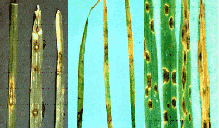|
All forage grasses grown in Illinois are susceptible to one or
more leaf spots and blotches, caused by species of the fungus Helminthosporium
(Pyrenophora, Cochliobolus, Leptosphaeria). Conspicuous losses may
occur in lush, dense stands during wet weather. Leaves killed by
the disease become weathered, low in food value, and less palatable
to livestock than normal leaves. The dead leaves reduce the quantity
and quality of both hay and pasture. Weakened plants are also less
likely to withstand drought and severe winters.
Infection may occur at almost any time during the growing season
when moisture remains on the leaves and leaf sheaths for several
hours. Infection usually starts on the older, lower leaves and progresses
upward to the younger leaves until checked by hot, dry weather.
Several widely distributed Helminthosporium species (e.g., H. sativum,
H. vagans, and H. victoriae) also cause seed decay and seedling
blight, as well as root, crown, and stolon rots of grasses and cereal
grains. (See Report on Plant Diseases No. 113, "Root and Crown
Rots of Small Grains"; No. 115, "Spot Blotch, Net Blotch,
and Stripe Disease of Barley"; and No. 405, "Helminthosporium
Leaf, Crown, and Root Diseases of Lawn Grasses.")
|

Figure
1. Helminthosporium leaf spots and blotches on (A) Kentucky
Blue Grass, (B) tall fescue, (C) smooth bromegrass.
|
Back to Top
Symptoms
Small-to-large spots (lesions), usually oval to oblong or elongated,
form on the leaves and leaf sheaths (Figure 1A-C). The lesions may be
yellowish-tan, reddish brown to purple-black (A), medium brown (B), or
dark brown (C) and are often surrounded by a yellowish border or halo
(C). The lesions may be up to half an inch long on most forage grasses
and 6 inches or more on Sudangrass and forage sorghums. (See Report on
Plant Diseases No. 202, "Northern Corn Leaf Blight" and No.
209, "Southern Corn Leaf Blight.") Older lesions usually have
a gray-to-straw colored center, surrounded by a dark red-to-brown or purplish-brown
margin. On fescues and other grasses, a net blotch symptom may develop.
The pathogen produces a net-like appearance of tiny, purple-to-brown lines
scattered over the surface of the leaves and stem (culm). Some lesions
may merge to form streaks; others may extend over the width of the leaf,
causing it to turn yellow or brown, wither from the tip, and die. Affected
plants may look scalded or as if injured by drought.
Back to Top
Disease Cycle
The Helminthosporium fungi overseason in or on seed, living or dead leaves,
and culms, or crowns; also, in other crop debris. The fungi produce spores
(conidia and ascospores) on dead or living grass in older lesions during
the early spring or summer and again in the fall. The spores are carried
by air currents and splashing rains to new growth on forage grasses. Infection
of the leaves, leaf sheaths, crowns, and seedlings occurs during damp weather
in the spring, summer, and fall.
Back to Top
1. Sow only certified, disease-free seed of improved, well-adapted grass
varieties, as recommended by University of Illinois agronomists and the
nearest Extension adviser.
2. Grow resistant varieties where they are available and are recommended.
For example, Piper Sudangrass is moderately resistant to Helminthosporium
turcicum. Most, if not all, sorghum-Sudangrass hybrids are much more resistant
than the great majority of Sudangrass varieties. Baylor and Blair are
smooth bromegrasses resistant to brown leaf spot or blight.
3. Treat the seed, where feasible, with a recommended fungicide. See
Report on Plant Diseases No. 1001, "Seed Treatments for Field Crops,"
for details. Seed treatment helps prevent the introduction of Helminthosporium
and other fungi or bacteria, carried on the seed, to new fields.
4. Plant at the recommended rate in a fertile, well-adapted seedbed.
Maintain adequate soil fertility, especially of potassium and phosphorus,
based on a soil test.
5. Avoid the following:
a. Excessive rates of fertilizers high in quickly available nitrogen.
b. Pure, dense stands of a single grass variety. Where practical, seed
a mixture of forages.
c. Close grazing and clipping. Follow recommended mowing and grazing practices.
d. Leaving a heavy mat of hay on the grass during damp weather.
6. Rotate with nongrass crops where practical. Rotation helps prevent
buildups of disease.
7. Keep down weed grasses by cultural or chemical means
8. If warranted, use a careful, controlled burning of dead grass in the
early spring when pastures are severely affected. This old practice destroys
organic matter, but kills leaf-blighting fungi and bacteria in the overwintering
leaves and crop refuse. Consult local EPA regulations about open burning.
Back to Top
|



